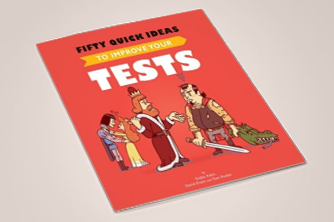 They’ve done it again. Gojko Adzic, David Evans and, in this book, Tom Roden, have written another ‘50 Quick Ideas’ book. And this one is equally as good as the previous book on user stories. If not even better.
They’ve done it again. Gojko Adzic, David Evans and, in this book, Tom Roden, have written another ‘50 Quick Ideas’ book. And this one is equally as good as the previous book on user stories. If not even better.
I got so much out of this book, and my tool belt expanded significantly. I really like the approach of these short, focused, one-topic books, starting with Gojko’s book on impact mapping. They don’t promise to be deep dives and total coverage, but rather to give you ideas (well… that’s in the title even), be challenged, and investigate further.
In this book on testing, they have divided the ideas into four groups, brushing on different aspects of testing:
- Generating test ideas
- Designing good checks
- Improving testability
- Managing large test suites
One of the things that struck me is how far (agile) testing has progressed during my relatively short period of interest in the field. This is a very sober and concrete look at the new breed of testers that want to be part in design, that takes failed tests as an opportunity to learn. We have sections on measuring test half times (how often do test change) in order to focus our testing efforts, and suggestions for how to involve and inform business users directly in the creation of key examples, etc. This is not your father’s testing… and I like it!
The early parts of this book touch more on organization of test efforts and exploratory testing, etc. There’s a lot of good things in there, but it’s not my area of expertise and interest.
The two last parts I found extremely interesting and packed with battled-hardened experiences that I sometimes found myself nodding in agreement with. And sometimes I had to reread paragraphs a few times because it was really a new take on a situation I’ve been in.
And that’s typically how you get the experiences from experts served. Some things you have experienced yourself and others are things that help your knowledge to take a jump ahead.
Everything that I didn’t know about before left me feeling that I wanted more pages on the topic. Or examples on how to implement this or that, although every Idea has a “How to make it work” section that gives you a starter.
This is by design.
The book is not meant to be a complete overview. You should, as they point out in the intro, not read this as your first book.
And, I might add: you should not read the entire book in one go. I would suggest that you browse this book for an overview and general knowledge and then use it as a tool, hands-on, in your team. Keep it next to your team, and as you run into problems, look them up in the book. There are a lot of pointers and ideas that can help you get under control many, if not all, of the testing problems I’ve seen teams run into.
I could not recommend the book more. Any serious agile tester should have this handy to be inspired to move even further.
Thank you, Neuri “Publishing” — looking forward to the next book. On retrospectives.
P.S. Were you the guys behind ‘50 Shades of Grey’ too?
This article originally appeared in the author’s blog, marcusoft.net.



















